About Us
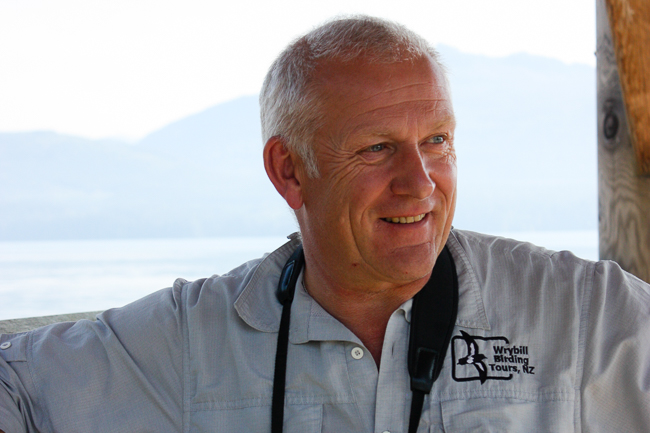
Ian 'Sav' Saville
Sav was born and brought up in London. He started birding in the early ’70’s and was fairly active in the British twitching/birding scene from then through to the late ’80s – building a British list of just on 400 (which was quite a lot in those days!). British birders will probably appreciate the following: Sav was an eye-witness to the infamous Reading Sewage Farm Black-winged Pratincole incident, he has seen TWO Tennessee Warblers in Britain, and he won many instant friends by finding an obliging Eye-browed Thrush on St. Mary’s in 1988.
Sav moved to New Zealand in 1989 and stayed for nearly 3 years, before having to return to UK in 1991. In late 1993 he went to Saudi Arabia for 2 ½ years (during which time he was a regular contributor to “Birding World”), and then arrived back in New Zealand in 1996.
In all this time Sav has travelled extensively, and been birding in each of the continents except South America. His 20+ years experience with British and European birds, and that gained during 8 trips to North America (both USA and Canada) will be of great use to visiting birders from those areas, since he is readily able to make comparisons with New Zealand birds.
His birding experience in New Zealand is also extensive, having travelled throughout the country on birding trips, as well as concentrating a lot of time on his ‘local patch’ – the Manawatu Estuary, where he has found many rarities among the common visitors. Sav has been the Ornithological Society of New Zealand (OSNZ) Regional Recorder (c.f. County Recorder in UK) since 1996, and was the OSNZ Regional Representative for the Manawatu Region from 2000-2011. He was then appointed to the OSNZ Rarities Committee. Sav moved to Hawkes Bay in early 2014, with the Ahuriri Estuary and surrounds now being his ‘local patch’.
He was a contributor to Hadoram Shirahai’s “Complete Guide to Antarctic Wildlife” published by Alula/Princeton University Press in 2002, writing the New Zealand portion of the “Gateways to the Antarctic” chapter.
Sav was also a key player in the rediscovery of the supposedly-extinct New Zealand Storm-petrel, being on the trip in January 2003 when the species was initially resighted, and being the first person onboard to see the bird. Read about the rediscovery here and the latest information here.
Contact Sav: Cell +64 276 803 740 | Email: sav@wrybill-tours.com
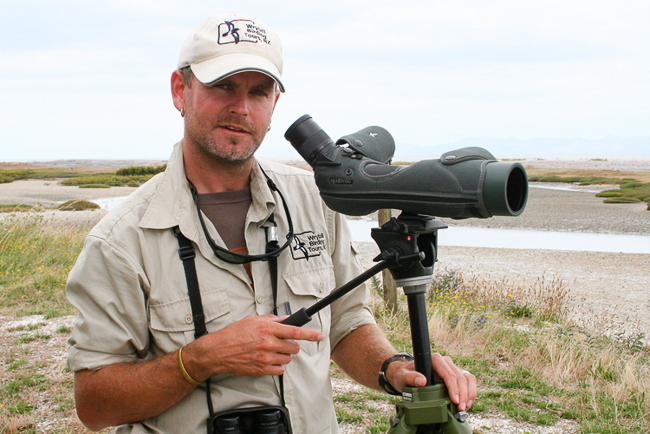
Brent Stephenson
Brent was born in Hawke’s Bay, New Zealand, in 1974 and was brought up in Hastings. He was interested in the outdoors and nature at an early age, taking his first photos of birds at about the age of 8 and then starting to bird soon after. During a family holiday to the UK in 1984 he began birding in earnest, keeping a record of the birds seen. This began the habit of a lifetime!
Birding and photography soon became serious infatuations, and his first sale of bird photographs was made at the age of 16. Starting a Bachelor Degree in Zoology at Massey University, led to birding taking a little bit of a back stage for a while, but it soon returned and during Brent’s Masterate on the ‘Ecology of Morepork’ – a small owl from the Ninox genus – birding once again became an infatuation.
Several trips to Australia soon started off a respectable Australian list, and in 1998 a trip to the UK and South Africa, began to build the foundations of his World List. In 2000 Brent took a trip with several mates to Queensland, Australia, managing to make it to the tip of Cape York and seeing some pretty sensational birds along the way. Another trip to Victoria, Australia in 2001 led to an Australian list tantalisingly close to the magic 500 species! This even includes a first for Australia, when Brent and his mate Rohan Clarke managed to find a chaffinch on Phillip Island near Norfolk Island.
In late 2001, Brent began the BIRDING-NZ newsgroup, to help with the exchange of birding information in New Zealand. Brent was also Regional Rep for the Hawke’s Bay OSNZ from 2000-2002, and was the webmaster for the OSNZ’s website for more than 10 years, creating the website from scratch in 2000.
On 24 January 2004, Brent left on possibly his biggest adventure to date, sailing with the John Ridgway ‘Save the Albatross’ Voyage 2003-4. The boat set sail for the Falkland Islands, rounding Cape Horn on the way. During the voyage Brent recorded and photographed the seabirds seen, as well as helping with the sailing of the boat – the English Rose VI. He then spent six weeks on the amazing Falkland Islands, where he realised that it was possible to work at sea. Later that year a trip to the Kermadecs with Mike Imber in search of the Kermadec storm-petrel, led to a boost in Brent’s NZ list, and he finished the year with the ‘record’ year list for New Zealand of 189 species – see the Birder’s totals page. This was however eclipsed in 2006, being the first person to reach 200 species in a calendar year, with 206 species.
Brent started a PhD on the ‘Ecology and breeding biology of Australasian gannets’ at Cape Kidnappers in 1999, and as can be seen from the trips listed above didn’t let it get in the way of his birding or travelling. Hence the thesis was not handed in until January 2005, much to the concern of his supervisors.
As with Sav, Brent was also a key player in the rediscovery of the supposedly-extinct New Zealand Storm-petrel, organising and participating in the trip in January 2003 when the species was initially resighted. The photos taken by Brent on that day were the first ever taken of a live New Zealand storm-petrel and led to the realisation that the bird seen wasn’t actually a black-bellied storm-petrel – see the photos and read about the rediscovery here and the latest information here. Since the discovery, Brent was initially involved in ongoing research on these birds, capturing six of these birds at sea, but is no longer involved due to other commitments.
Since finishing his PhD Brent has worked in a number of different areas, having worked for Department of Conservation (Boundary Stream Mainland Island), contract research work for proposed Windfarm projects, involvement in the Cape Kidnappers and Ocean Beach Wildlife Preserve, and work on small Expedition cruise ships. Since 2006 he has worked on small Expedition cruise ships for a number of different companies, in Antarctica, the Arctic and many places in between (38 countries in 2008 alone!), all started from a seed sown in the Falkland Islands. Currently, he spends part of his year living in Vermont with his wife Lisa, some of the year on small ships as Expedition Leader, and the summers guiding here in New Zealand. He also runs his photography business from wherever he is – most of the photos on this site were taken by him. The highlight for 2013 was publishing his first book – Birds of New Zealand: A Photographic Guide – detailed on the FAQ page. Check out his photography website – www.eco-vista.com
Contact Brent: Cell + 64 274 426 638 or +1 716 319 4434 | Email: brent@wrybill-tours.com
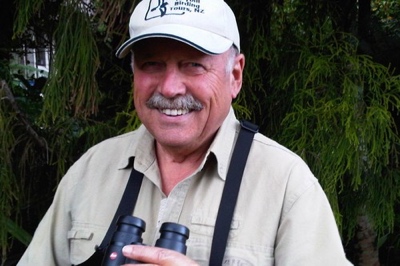
Phil Hammond
Phil Hammond was born in Canada, but spent his boyhood in small villages in rural Norfolk, England, where he grew a passion for nature and birds and acquired what Norfolk people in those days called a “countryman’s eye” [roughly translated as a tendency to notice small details in nature].
Although he has travelled to more than 30 countries, his home base for the last 50 years has been Auckland and he is proud to be a Kiwi.
In his 20s, 30s, and 40s sport, career, and young family took most of his time but he always had a pair of binoculars and a bird book or two [he now has over 100!]. He first joined ‘Forest and Bird’ over 30 years ago.
His interest in birds turned full circle when, in 2003, he dumped his casual NZ bird list and started from scratch listing only birds absolutely positively identified, and a general interest returned to a passionate obsession. Since then his NZ list has passed 275 species.
He loves nothing better [except a successful twitch] than watching a big flock of 1000s of shorebirds for 4 or 5 hours hoping to pick out something unusual from the mass, although his favourite ticks on his NZ list, have been as diverse as Black Robin, Bounty Island Shag, Dunlin, Straw-necked Ibis, and Franklins Gull.
He has served on the executive council at Miranda for several years and also on the Bird Roost Advisory Group in the Manukau harbour, and is a regular attendee at OSNZ meetings, censuses etc. He really enjoys showing visitors our birds, especially endemics, and knows where to find them.
Contact Phil: Cell + 64 21 141 3892 | Email: philxhammond AT yahoo.com
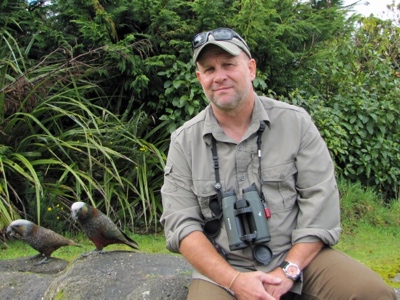
Matt Jones
Matt was born in Kent in the south east of England and from a young age had an interest in all wildlife but particularly birds. He was a proud member of the Young Ornithologists Club and always had his nose in a bird book.
During a brief gap in bird watching Matt played a high standard of rugby, including representative level, and was fortunate enough to play at Twickenham.
Early years of birding were spent in his home county at Dungeness, Elmley and Oare Marshes. Kent with its corridor of marshland and reed beds provided the ideal location for Matt to get his fix of waders, one of his favourite groups of birds.
The twitching and listing bug soon took a hold and Matt travelled the UK far and wide to get birds on his list, finding a few rarities along the way such as American Robin and Roller. His UK list stands at over 400 birds.
Overseas birding initially took Matt to Mallorca where most British birders cut their teeth birding away from their home turf. He has since travelled extensively around Europe, North America, Asia, Pacific Islands as well as Australia and New Zealand. Highlights of these trips included seeing Tiger in India, Leopard in Sri Lanka and most recently Kagu in New Caledonia. The Kagu was on Matt’s “most wanted bird” list and is now on his world list!
It was during one of these trips to New Zealand that Stewart Island found its way into his heart and since 2007 is where he calls home. As a freelance bird watching guide, Matt enjoys showing fellow bird watchers the vast variety of seabirds on pelagics, the endemics of Ulva Island, and the iconic kiwi during evening trips. He has led TV and film crews on his trips, and also works on an annual project to monitor forest bird call counts.
On his days off, Matt goes bird watching! Stewart Island is not the easiest place to twitch from so he has become a local patch watcher finding his own rarities. These include Black-faced Cuckoo Shrike, White-naped Petrel on Stewart Island and a Nankeen Kestrel in Southland.
Matt began dabbling in digi-scoping in the late 1990s. He has since upgraded to a digital SLR and has been fortunate enough to have his images published in books, magazines and websites both nationally and internationally, but he sees himself as a bird watcher first and photographer second. Visit Matt’s website.
In his spare time, he has volunteered for the Department of Conservation; in 2009 for the Kakapo Recovery Programme on Codfish Island; in 2010 helping to tag Great White Sharks off Stewart Island; and most recently gathering data for the Southern New Zealand Dotterel project.
He is also a volunteer for the Stewart Island/Rakiura Community & Environment Trust doing Blue Penguin surveys, banding Sooty Shearwaters and Kiwi/Morepork/Weka bird call counts. In 2011 Matt became Chairman of the Ulva Island Charitable Trust, a group that (with DoC) works towards keeping Ulva Island open to the public, remaining predator-free, and aspiring to be one of New Zealand’s premier bird watching locations.
Contact Matt: Cell + 64 27 213 1155 | Email: matt AT mattjoneswildlifeimages.com
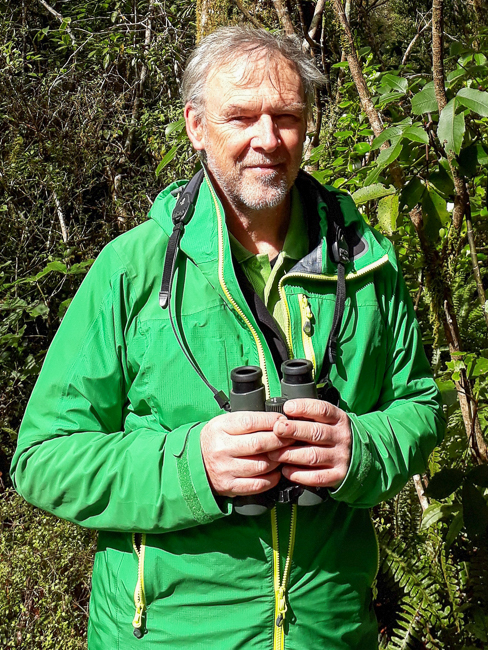
Neil Robertson
Neil spent his early years on his parents’ farm in Kent, south east England, and has had a keen interest in wildlife and birds for as long as he can remember. He tried bird photography for a while during the early seventies without much success, so eventually settled on being a bird watcher first with occasional photos as a bonus.
In his final years at school he would often ‘bunk-off’ early with a mate to go sea-watching from the sea cliffs on the Isle of Thanet and remembers seeing and photographing the very first Northern Fulmars to breed there in the early seventies.
Another friend met while studying at Nottingham University in the early to mid-seventies introduced him to bird ringing and the Wash Wader Ringing Group and the next few years found him mist-netting and cannon-netting a wide variety of waders along the Lincolnshire and Norfolk coast. He continued his ringing training at Sandwich Bay Bird Observatory, where he encountered a wide range of migrant passerines, marshland breeding birds at Stodmarsh and Sturry Lakes and the shore-birds at Pegwell Bay.
Career and family commitments in Scotland during the early 80s meant Neil’s birding activity slowed down for a while, but he still regularly worked a local patch at Fife Ness on the east coast, where he found a number of rare migrants and vagrants, including the first red-billed chough in Fife for nearly a century. The late 80s saw the twitching bug take hold and soon Neil was combining work trips with birding in many parts of the UK, with an annual mid-October trip to Scilly becoming a regular feature. When he left the UK to move to New Zealand in 2005 his UK list was 435.
Overseas birding initially took Neil to Florida, Australia and New Zealand and Trinidad and Tobago during the 90s. He has since travelled and birded extensively in Europe, North America, South America, South Africa, India, China, Australia and South-east Asia.
Neil has spent the last ten years guiding in Fiordland, a huge national park in the far south west of New Zealand’s South Island, showing his guests the amazing scenery and wildlife in this very special area.
Contact Neil: Cell + 64 21 152 6275 | Email: neil.robertson AT osnz.org.nz
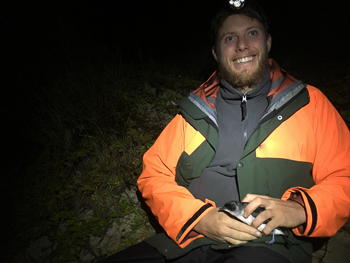
David Thomas
David grew up on a small farm in the Waikato, near Hamilton, where he developed a keen interest in birds and other wildlife. Encouraged by interested parents and an elder brother, he spent many long weekends on Tiritiri Matangi Island near Auckland. On ‘Tiri’ he fell in love with Kokako, Takahe and Saddleback, among the other amazing range restricted endemics.
During his later teen years David spent considerable time birdwatching with his elder brother, exploring the many estuaries that northern New Zealand has to offer. David was also an integral part of the Raptor Association of New Zealand falcon surveys in the Kaingaroa Forest; nothing gets the blood going like being dive-bombed by a bird of prey intent on murdering you.
David attended the University of Canterbury in Christchurch, studying a Bachelor of Science focusing on Ecology and Animal Behaviour. He also spent a summer working as a Research Assistant in Kowhai Bush; mist-netting and banding (ringing) small passerines, and nest searching to assist with Shining Bronze-Cuckoo research. David’s first pelagic trip was out of Kaikoura, and this set in motion a slippery slope of seabird obsession. David’s ultimate goal is to see all of the worlds species of Tubenoses, of which he is up to over 50 species, the vast majority of these in New Zealand, including the endemic Chatham Albatross, New Zealand Storm Petrel and Mottled Petrel. This also includes the critically endangered Whenua Hou Diving Petrel; with which he helped as a research assistant for a month, banding and monitoring the single population.
David is heavily involved in the birding scene within New Zealand; is a moderator on the Birdingnz forum and has helped with two recent BirdsNZ youth camps, encouraging and nurturing the young birder scene in New Zealand. He also is a significant contributor to the New Zealand Bird Atlas scheme a collaboration between BirdsNZ, the Department of Conservation and WMIL. He has also held the record with friends for the Big Day amassing a total of 108 species within 24-hours and raising over $1,300 for the Hutton’s Shearwater Trust in the wake of the Kaikoura Earthquake. David was also one of the youngest ever members of the Birders’ Totals ‘200 Club’ at age 26.
Currently David works for the Department of Conservation as a Biodiversity Monitoring Ranger; where his day to day life takes him all around the country measuring trees, and bird and mammal pest abundance. He has a huge passion for sharing the wonders of New Zealand’s environment with others, and is quite a keen wildlife photographer also.
Contact David: Cell + 64 27 499 1144 | Email: davidthomas.mville AT gmail.com

Andrew Crossland
Andrew was born in Riwaka and grew up in Christchurch. Getting into exploring at age 3, and birding at 14, his foremost ornithological passion has always been the feathered inhabitants of coastal mudflats and salt marshes. He learnt this trade initially on the sand spits of Tasman and Golden Bays, and also the estuaries and coastal lagoons of Canterbury. A chance discovery of New Zealand’s first (1985) and third (1988) Asian Dowitchers, as well as coming across some old, but very detailed pre-war maps of the coastline of Sumatra led to the first of many shorebird-focused expeditions to Indonesia in 1994. In the 25 years since, Andrew has found tens of thousands of shorebirds on hitherto unknown sites in Sumatra and elsewhere in the Indonesian archipelago, expanding his field work to other parts of South East Asia and the Pacific. Back home in New Zealand, Andrew has managed a monitoring programme of shorebirds and waterbirds on Central Canterbury wetlands for more than 35 years; has been the South Island co-ordinator of the National Wader Survey for the past decade, and like Sav, currently serves as a member of the Birds New Zealand “Records Appraisal Committee” (aka rarities committee). In 2019 Andrew was awarded the Sir Robert Falla Memorial Award for long and distinguished service to Birds New Zealand.
Andrew works hard to bridge the gaps between different components of the ornithological world. He is a keen birder and twitcher and a regular contributor to the Birdingnz Forum. He has co-authored a book on the estuaries of Christchurch, wrote a newspaper column for 6 years on Canterbury birdlife, and undertakes a great deal of public speaking and outreach, including Christchurch’s annual “Farewell to the Godwits” event, which attracts 500-900 people. Andrew also takes the science of ornithology seriously, having authored more than 100 journal papers and technical reports in his role as a professional ornithologist for the Christchurch City Council. Andrew currently works as an ecologist for the Parks Biodiversity Team of the Christchurch Council, having recently shifted from an 18 year stint as a park ranger -project manager with the city’s regional parks team. His responsibilities include monitoring and managing birds and their habitats across the central Canterbury area, including Christchurch City, Banks Peninsula and Lake Ellesmere.
Andrew’s birding experience around the main islands of New Zealand is extensive, having explored every part of the country since teenage years and having co-led birding tours around the country. Aside from an extensive knowledge of birds and the local environment, Andrew has degrees in both New Zealand geography and history, so can tell a good story or two about the places and the people as well as the wildlife.
Contact Andrew: Cell +64 27 434 1155 | Email: andrewcrossland99 AT gmail.com
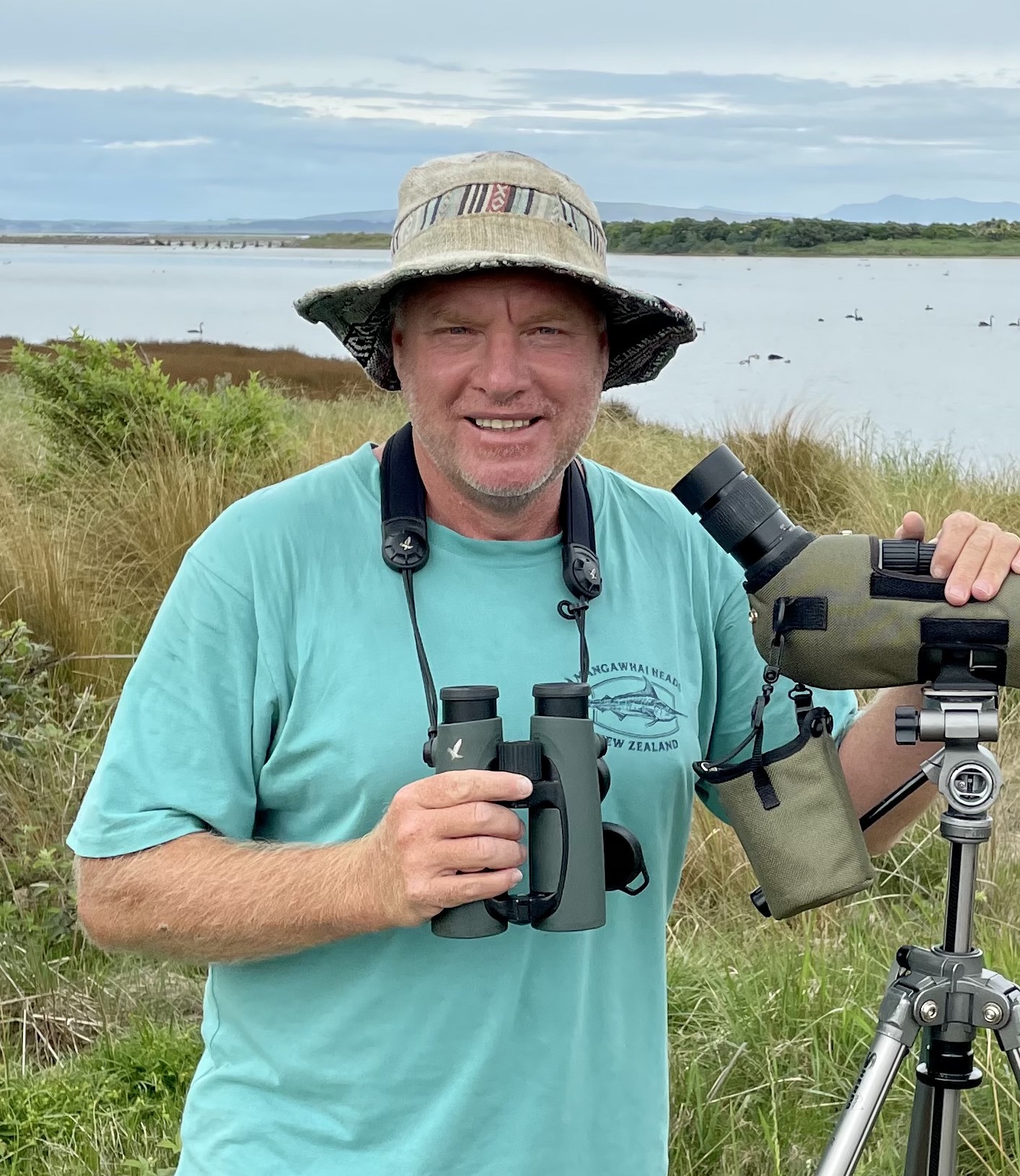
Dave Howes
Dave was born and raised in Cape Town. He was introduced to the great outdoors at the age of 3 months when his parents took him camping for the first time. While not a birder, Dave’s Dad was a keen outdoors person with a good general knowledge of birds and wildlife and this certainly rubbed off. He built his first bird hide in his parents backyard around the age of 10 but then got sidetracked into aviary birds with a specific interest in Australian finches.
At high school he became more interested in snakes as this was seen as “cooler” than birding and several of his friends enjoyed this as well. Birding took a bit of a back seat during University, starting a career and getting married.
After a few years of marriage, Dave and his wife bought an old Landrover and used to spend about 5 weeks a year in Botswana, Namibia and Zimbabwe at which time his interest in birds was rekindled.
Dave and his family emigrated to New Zealand in 2001 and birding again took a back seat while the family settled in and a new career was forged.
In recent years, with children grown up and doing their own thing, Dave has once again picked up his binoculars and spends as much time birding as possible. His main interests are waders/shorebirds and seabirds and as a keen diver and angler, he gets to spend a bit of time at sea.
In 2021, Dave set out to set a New Zealand “Big Year” record and after trips to the Kermadecs, Chatham and sub-Antarctic islands, he ended the year on 250 species, which is the new record New Zealand record.
Contact Dave: Cell +64 21 770 780 | Email: dave AT cape.net.nz
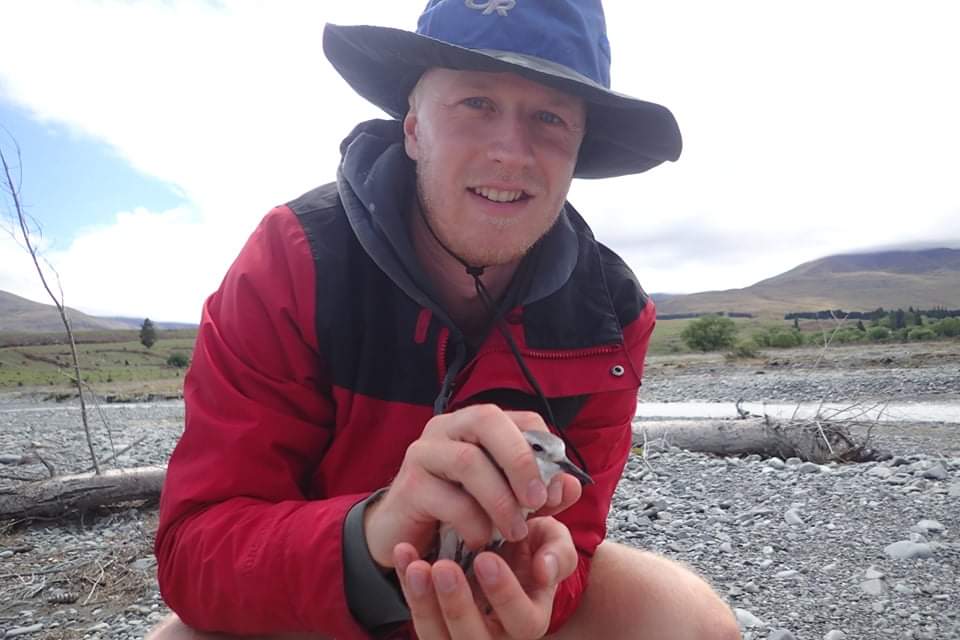
Fraser Gurney
Fraser was born and raised in Christchurch. His parents had a good appreciation for nature which rubbed off on Fraser, with birds becoming his main point of interest from about age seven. This interest was fuelled by many family holidays to all corners of New Zealand, particularly in the South Island, where encounters with endemic birds such as kea and blue duck made a particular impression. During his high school years several trips to Australia saw Fraser keeping his first lists, turning his interest in birding into a real passion.
Fraser attended Lincoln University near Christchurch, where he studied a Bachelor of Science majoring in conservation and ecology. Upon completing his degree, he started work as a guide in South Westland at Wilderness Lodge Lake Moeraki, specialising in showing guests the endemic Fiordland crested penguin. Following this, Fraser worked for the Department of Conservation (DOC) as a Biodiversity Monitoring Ranger, where he spent more time in the Westland area and developed an affinity for the West Coast and its birds. Following his two-year stint with DOC, Fraser returned to Lincoln University to pursue a Master of Science, which he completed in 2022. His thesis saw him GPS tracking the endemic black-fronted tern and become an expert on New Zealand’s braided river birds. He currently lives in Christchurch where he works as an ornithologist for ecological consultancy Wildland Consultants.
Since his time with DOC, Fraser has been a very active member of the New Zealand birding scene. As a twitcher, his birding has taken him throughout the country, while more locally he is on the committee for the Canterbury branch of Birds NZ, moderates the New Zealand Bird Identification Facebook page and takes part in voluntary bird surveys and conservation projects throughout the Canterbury region. In 2022, Fraser’s New Zealand list passed 250 birds, making him one of the youngest people to pass this milestone at age 25.
Contact Fraser: Cell +64 27 789 5318 | Email: frasergurney AT gmail.com
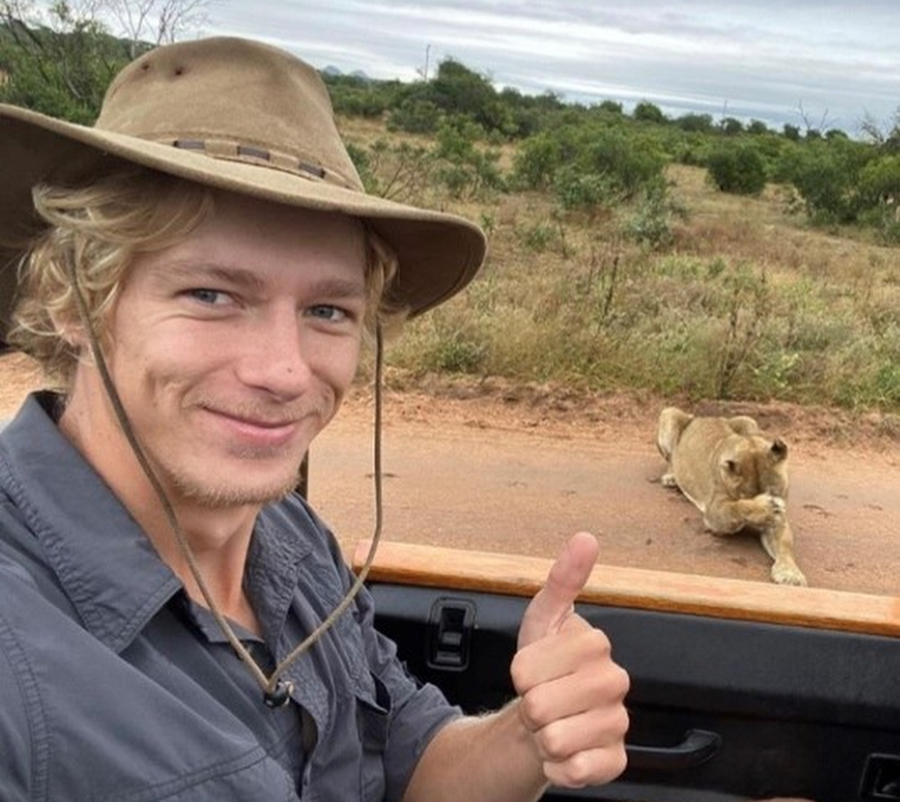
Mathieu Poot
Mathieu grew up in Whangarei and in the Far North of New Zealand. He had a keen interest in nature from an early age and as a boy loved looking for birds, reptiles and creepy crawlies.
Mathieu studied Agricultural Science at Massey University in Palmerston North, with a focus on New Zealand Flora and Fauna. He started his working career with the Ministry for Primary Industries, working in Biosecurity and as a Fisheries Officer.
Following that he moved to South Africa to train as a Safari Guide. During this time, his interest in birds began to escalate and by the time he started working as a Safari Guide in the Sabi Sands, birding was one of his specialties. Mathieu loved finding unique birds for guests and found that it added a special twist on the usual “Big 5” safari. He found a number of regionally rare birds in his local area, such as a Narina Trogon, African Pygmy Goose and African Skimmer. His Mpumalanga and Limpopo lists both sit at over 400 species.
Since coming back to New Zealand, Mathieu has been involved in conservation work, including working for the Department of Conservation on the Kaki (Black Stilt) Recovery Programme in Twizel. Mathieu was part of a field team whose job was identifying and monitoring breeding pairs and collecting their eggs when they had laid a full clutch. These eggs were then artificially incubated, hatched and grown to adult size, before being released back into the wild. Mathieu also works as a nature guide in Fiordland, one of New Zealand’s most dramatic and untouched landscapes.
Mathieu has birded the length of New Zealand, from Cape Reinga to Campbell Island, and spends a lot of time birding in his home patch around Northland. He has a specific interest in seabirds, as well as fishing and freediving, so spends a lot of time out on the water. Regular pelagic trips off the Karikari Peninsula have seen him find a wide variety of seabirds in the Far North, notably a Great Frigatebird and Sooty Tern. Mathieu’s New Zealand bird list currently sits just under 200 species, with work ahead to tip it over the 200 mark!
Contact Mathieu: Cell +64 27 262 9579 | Email: Mathieu.poot AT gmail.com
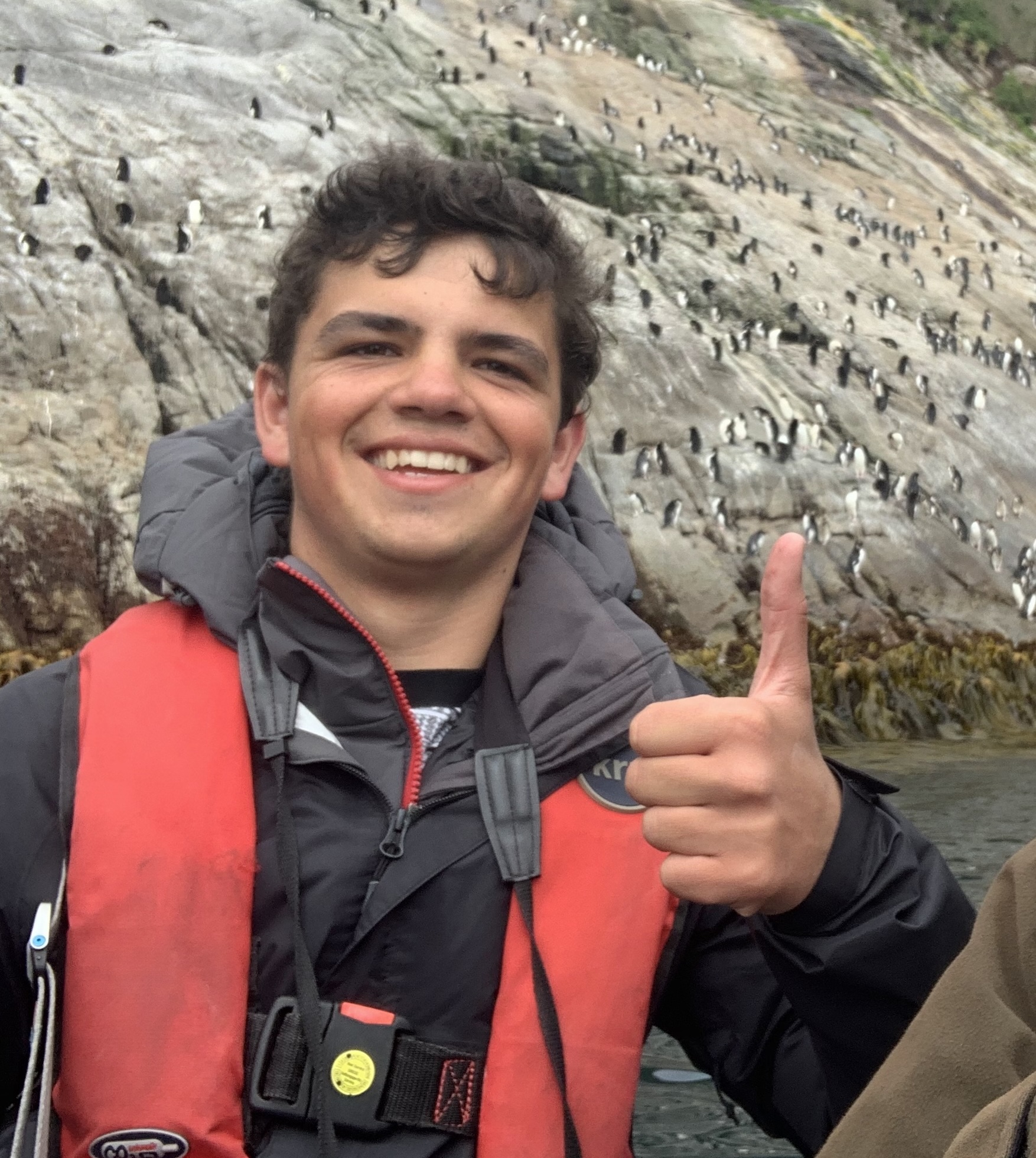
Bradley Shields
Returning to New Zealand Bradley began biking around the countryside looking for new and different species, particularly interested in rarer species such as crakes, and bittern. Bradley also co-found a mega Pallid Cuckoo at the end of 2019, at the time it was only the 7th New Zealand record.
Bradley has been involved with conservation since the age of 15 and throughout High School was a youth ambassador for Project Janszoon, a project aimed at restoring biodiversity in the Abel Tasman National Park. He also volunteered with Department of Conservation to help study the critically endangered Australasian bittern and declining marsh crake, as well as a 3 week stint with the kakapo recovery team on Whenua Hou / Codfish Island.
Since finishing High School he began having more freedom to explore the country and find/ twitch rare birds. Self found rarities include, whiskered tern, hudsonian godwit, arctic tern, common tern (x7), great knot and Gould’s petrel. He is also a keen eBird user and lister, being the top in West Coast and Tasman regions and seeing 206 species in 2024 alone.
Bradley started a job with Zero Invasive Predators (ZIP) doing landscape scale (100,000ha!) predator elimination on the West Coast of the South Island. He instantly fell in love with the location for its scenery and wildlife and also the incredible recovery of native species he saw, largely due to the predator removal work taking place. Okarito became his main stomping ground where it is now one of the most healthy and bird abundant forests in the country.
After 2 years living in Franz Josef, he now lives on Rakiura / Stewart Island beginning the work to remove introduced rats, cats and possums from the 178,000 hectare Island and save charismatic and critically endangered species like Pukunui / Southern New Zealand dotterel from extinction.
Contact Mathieu: Cell +64 272 243 014 | Email: bradleyshields.photography AT gmail.com